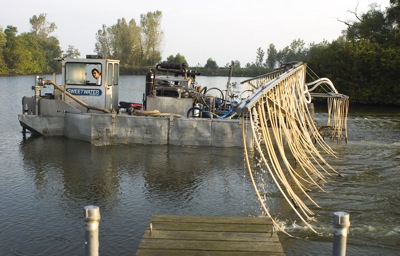Thursday, September 23rd, 2010
Pilot test: Alum in
Early results positive at Grand Lake site
By Nancy Allen

Photo by Mark Pummell/The Daily Standard
A barge applies liquid alum in Grand Lake at Harmon's Landing this morning. Alum is expected to cause phosphorous in the water to bind together and sink to the bottom, taking away the main food source for the lake's toxic blue-green algae. Two more sites at Otterbein Retirement Community were also treated today and sites at the Mercer County 4-H camp and the West Bank boat ramp will be treated Friday.
GRAND LAKE - Water was visibly clearer this morning just hours after a pilot study began on Grand Lake.
A 30-foot-long barge with 60 foot-wide arms attached to dangling hoses applied more than 6,000 gallons of aluminum sulfate (alum) over 13 acres at Harmon's Landing, the first of five sites that will be treated.
The alum targets phosphorous, the main food source for the toxic blue-green algae that has plagued the lake for years.
Scott Fletcher, with the Ohio Department of Natural Resources, said the visibilty in the lake's water had increased from 2 to 8 inches just a few hours after the application began.
A combination of sodium aluminate, a form of alum with a high pH, and aluminum sulfate, which has a low pH, was used. The mixture is designed to ensure there are no spikes in water acidity that could harm fish.
"The goal is to keep it neutral" said John Holz of Tetra Tech, the consulting firm hired to design the alum study and analyze the results. "When you get high or low pH, you can get impacts in aquatic life."
Shortly after the alum was applied, 3-inch long gizzard shad started swimming to the surface seeking air. Fletcher said the behavior was expected and temporary. The reaction was not caused by the chemical, rather from some of the algae dying quickly as it was carried to the lake bottom with the phosphorous.
Alum causes phosphorous and some of the algae to bind and drop, making the phosphorous unavailable to the algae to eat, Fletcher said. When algae decomposes it takes up oxygen, which can drop dissolved oxygen levels. Application was suspended for 90 minutes to allow the oxygen level to increase, Fletcher said.
Dissolved oxygen levels will be monitored throughout the 60-day study, Fletcher said.
"If there is a fish kill, this might help explain why, but it would be temporary," he said. "Once the algae decomposes, we would expect dissolved oxygen levels to come back up."
Holz said shad are a weaker species that reacts adversely to low oxygen levels.
"We're starting with a lake that has very low dissolved oxygen levels to begin with," he said. "You're going to have some of this."
Two channels at Otterbein Retirement Community - one measuring 7.55 acres and a second 5.25 acres - also were scheduled for treatment today. Officials will complete the test at the last two sites on Friday, which include 10.18 acres at the Mercer County 4-H camp and 8.75 acres at the West Bank boat ramp. A sixth 8.11-acre test site at the west beach will not receive any alum because it is the control site.
Curtains have been installed in the lake around each of the sites.
The cost of the pilot project is being funded by a $250,000 Ohio EPA grant.
The 40,000-gallon liquid alum application is one of two treatments proposed by the state to help eradicate toxic blue-green algae blooms that plagued the 13,500-acre lake this summer. The goal of the other test, a silica (sand) treatment, is to feed a good algae that would overtake the toxic blue-green algae. This test site is near the Celina Rotary lighthouse.
If either alum or silica is shown to work, they could be used lakewide to give officials time to permanently decrease phosphorous coming into the lake from the 59,000-acre watershed. Most of the phosphorous that enters the lake comes from farmland, which makes up more than 80 percent of the watershed acreage.

Photo by Mark Pummell/The Daily Standard
Grand Lake's water appears mottled after liquid alum was applied at Harmon's Landing this morning. Alum is expected to cause phosphorous in the water to bind together and sink to the bottom, taking away the main food source for the lake's toxic blue-green algae. Two more sites at Otterbein Retirement Community were also treated today and sites at the Mercer County 4-H camp and the West Bank boat ramp will be treated Friday.


